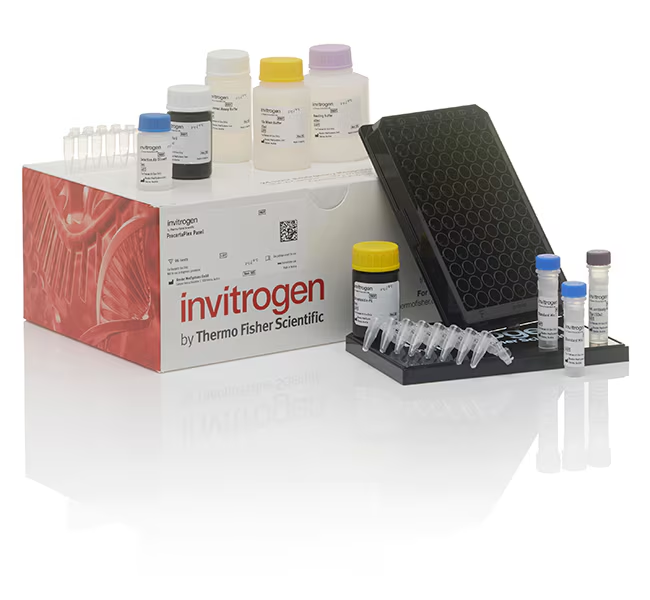
The ProcartaPlex Human Immuno-Oncology Checkpoint Panel 2 14plex enables cancer research by analyzing 14 protein targets using Luminex xMAP technology. This panel allows simultaneous detection of soluble NK cell checkpoint molecules that regulate NK cell activation against tumor cells by the balance of inhibitory or activating signals. Analysis of these soluble biomarkers could help to shed light on the biology of the pathways. It complements Human Immuno-Oncology Checkpoint Panel 1 14plex (Cat. No. EPX14A-15803-901) and Human Immuno-Oncology Checkpoint Panel 3 9plex (Cat. No. EPX090-15820-901), providing 23 additional protein targets in the same research area.
ProcartaPlex preconfigured panels are extensively tested for analyte combinability, interference, and cross-reactivity to provide the highest level of validation and precision. All ProcartaPlex panels are supplied with the necessary reagents to perform the assay.
Target list [bead region]:
Activating: MICA [18], MICB [21], Perforin [53], ULBP-1 [73], ULBP-3 [77], ULBP-4 [78]
Inhibitory: Arginase-1 [51], CD73 (NT5E) [30], CD96 (Tactile) [35], E-Cadherin [44], Nectin-2 [29], PVR [56], Siglec-7 [12], Siglec-9 [13]
About ProcartaPlex assays for the Luminex platform
ProcartaPlex immunoassays are based on the principles of a sandwich ELISA, using two highly specific antibodies binding to different epitopes of one protein to quantitate all protein targets simultaneously using a Luminex instrument. ProcartaPlex multiplex assays require as little as 25 μL of plasma or serum, or 50 μL of cell culture supernatant, and just four hours to obtain analyzed results.
Features include:
• Reproducible, reliable results—validated as a panel to the highest industry standard, including protein target combinability and cross-reactivity testing
• More results per sample—measure multiple protein targets simultaneously in a single 25–50 μL sample
• Well-established Luminex technology highly referenced multiplexing platform for protein detection and quantitation
ProcartaPlex assays utilize Luminex xMAP (multianalyte profiling) technology for the simultaneous detection and quantitation of up to 80 protein targets in a single 25–50 μL sample—from plasma, serum, cell culture supernatants, and other bodily fluids.
The Luminex beads in the ProcartaPlex assay are internally dyed with precise proportions of red and infrared fluorophores to create spectrally unique signatures that can be identified by the Luminex xMAP detection systems (e.g., Luminex 200, FLEXMAP 3D, and MAGPIX). Similar to a sandwich ELISA, the ProcartaPlex assay uses matched antibody pairs to identify the protein of interest. In a multiplexed assay, each spectrally unique bead is labeled with antibodies specific for a single target protein, and bound proteins are identified with biotinylated antibodies and streptavidin–R-phycoerythrin (RPE). The conjugation of protein-specific antibodies to a distinct bead allows for analysis of multiple targets in a single well.
The most significant difference between a ProcartaPlex assay and ELISA is that the capture antibody in the ProcartaPlex assay is conjugated to a bead and not adsorbed to the microplate well, so the ProcartaPlex assay reagents are free-floating in the solution. For detection, the Luminex 200 instrument, for example, contains two lasers, one to distinguish the spectral signature of each bead and the second to quantify the amount of RPE fluorescence, which is proportional to the amount of protein present in the sample. ProcartaPlex multiplex assays can profile more target proteins using significantly less sample in the same time that it takes to perform a traditional sandwich ELISA.
| Code | Description |
|---|---|
| EPX140-15815-901 | Catalog Number: EPX140-15815-901 |

